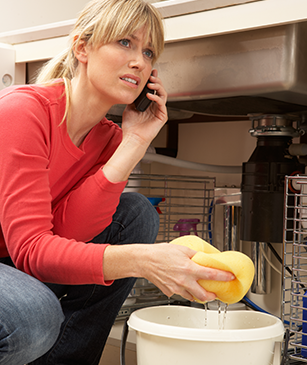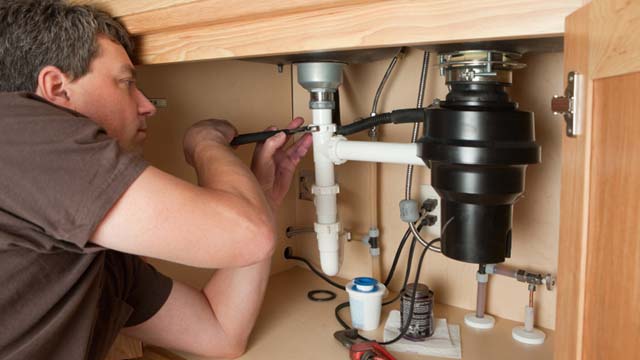Best Methods for Resolving a Leak in Your Garbage Disposal
Best Methods for Resolving a Leak in Your Garbage Disposal
Blog Article
They are making a number of great pointers relating to Why Is My Garbage Disposal Leaking From the Bottom? as a whole in this great article on the next paragraphs.

Garbage disposals are important cooking area home appliances that assist in taking care of food waste effectively. However, a dripping waste disposal unit can be an aggravating and untidy trouble to deal with. Thankfully, lots of leakages can be dealt with easily with a few easy steps. In this article, we will certainly review just how to deal with a dripping waste disposal unit efficiently.
Introduction
Garbage disposals are mounted under cooking area sinks and are designed to shred food waste right into smaller pieces, allowing it to pass through the plumbing system conveniently. While these tools are normally trusted, leakages can occur over time as a result of damage, loosened connections, or damage to the unit.
Step-by-Step Overview to Dealing With a Dripping Garbage Disposal
Shut off the Power
Before trying any repairs, make sure that the power to the garbage disposal unit is switched off to prevent the threat of electric shock.
Locate the Leak
Determine the specific place of the leakage and figure out the cause
Tighten up Connections
Use a wrench to tighten up any type of loose connections in between the disposal system and the pipes system.
Replace Seals or Gaskets
If the leakage is due to used seals or gaskets, eliminate the old elements and replace them with new ones.
Patching Splits or Openings
For fractures or holes in the disposal device, usage epoxy or an ideal patching material to secure the damaged area.
Identifying the Resource of the Leakage
Prior to attempting to take care of a dripping garbage disposal, it is necessary to recognize the source of the leak. This can generally be done through visual evaluation or by carrying out simple tests.
Visual Examination
Examine the garbage disposal device meticulously for any type of indications of water leak. Pay very close attention to areas around seals, gaskets, and connection points.
Checking for Leaks
One way to evaluate for leaks is by running water with the disposal device and checking for any type of visible signs of leakage.
Usual Reasons For Leakages in Trash Disposals
Worn Seals and Gaskets
Seals and gaskets play a vital function in protecting against water from leaking out of the waste disposal unit. With time, these elements can degrade, resulting in leakages around the disposal device.
Loose Links
The links in between the garbage disposal and the pipes system can come to be loosened with time, causing water to leakage out during operation.
Fractures or Holes in the Disposal Unit
Physical damages to the garbage disposal, such as cracks or holes in the housing, can additionally lead to leaks.
Tools and Materials Needed for Dealing With a Leaking Waste Disposal Unit
Before starting the repair work procedure, gather the essential tools and products, consisting of a screwdriver, flexible wrench, plumbing professional's putty, substitute seals or gaskets, and epoxy or patching product for fixing splits or holes.
Evaluating the Garbage Disposal After Repair Work
As soon as the repair is full, examine the waste disposal unit by running water via it to guarantee that the leakage has actually been settled.
Preventive Upkeep Tips to Prevent Future Leaks
To prevent future leakages, it is important to carry out regular maintenance on your waste disposal unit. This includes keeping it tidy, avoiding placing non-food items or tough items down the disposal, and regularly checking for leakages or other concerns.
Verdict
In conclusion, fixing a leaking garbage disposal is a fairly simple procedure that can be finished with standard devices and materials. By following the actions laid out in this post and practicing preventive upkeep, you can keep your waste disposal unit in good working condition and avoid pricey repair services in the future.
What to Do About a Leaking Garbage Disposal
A leaking garbage disposal often goes unnoticed until you confront a sopping cabinet, a foul-smelling puddle, or an audible drip-drip-drip from the unit. The fix can be frustrating, too, because the leak can stem from a number of components in the system. Fortunately, with a little sleuthing, you can zero in on the leak and—depending on the exact location—stop the icky oozing and repair the component that caused it. Worst case scenario, if it turns out that the garbage disposal must be replaced, installing a new one is a reasonable do-it-yourself task for those with basic plumbing skills. Read on to keep the cash you’d otherwise hand over to a pro.
Prepare to find the leak
Prior to testing the garbage disposal for leaks, unplug it at the wall outlet and turn off the power from the breaker box to prevent electrical shock. Then insert a watertight sink stopper into your sink drain and wipe the unit dry with a clean cloth. In any handy container, mix a few drops of food coloring into a few cups of water, and pour the dyed water onto the sink stopper to help you locate the leak.
Investigate the source
the top, where the disposal meets the sink drain the side, where the dishwasher hose or main drain pipe connects to the disposal or the bottom of the unit Inspect each of these locations while gliding a light-colored rag over the unit; the dyed water will readily show on the rag and reveal the location of the leak. If a leak isn’t immediately apparent, remove the sink stopper and pour a few more cups of dyed water down the sink drain, then check for leaks again. Leaks near the top of the unit are more likely to show themselves while the sink is plugged, while side and bottom leaks are more noticeable while the sink is unplugged.
The metal sink flange that sits directly inside the sink drain is typically sealed around the top with plumber’s putty (a clay-like sealant) and then secured from under the sink with bolts. If the plumber’s putty deteriorates, or the bolts loosen, the flange can no longer form a watertight seal between the sink drain and the disposal—which could cause a leak at the top of the unit.
To reseal the leaky flange, you must first detach the garbage disposal. Start by loosening the screws securing the main drain pipe to the disposal, then loosen the screws in the metal clamp securing the dishwasher hose to the disposal and detach the drain pipe and dishwasher hose from the disposal. Loosen the screws in the mounting ring that connects the disposal to the metal mounting assembly beneath the sink, then pull down the disposal and carefully set it on a clean, dry surface. Loosen the bolts in the mounting assembly with a wrench, then pull down the mounting assembly and set it near the disposal.

As an avid reader about Tips on Fixing a Leaking Garbage Disposal, I think sharing that excerpt was worthwhile. Kindly take a moment to distribute this page if you liked it. We take joy in reading our article about Why Is My Garbage Disposal Leaking From the Bottom?.
Maintenance Sign-Up Report this page